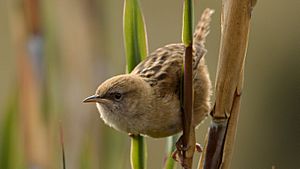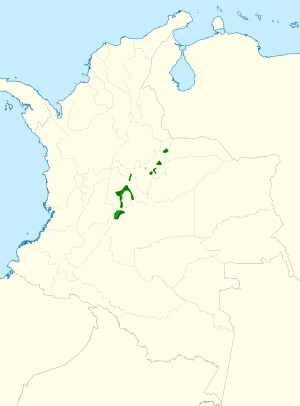Apolinar's wren facts for kids
Quick facts for kids Apolinar's wren |
|
|---|---|
 |
|
| Conservation status | |
| Scientific classification | |
| Genus: |
Cistothorus
|
| Species: |
apolinari
|
 |
|
The Apolinar's wren (Cistothorus apolinari) is a small passerine bird that belongs to the wren family, Troglodytidae. This special bird lives only in Colombia, which means it is endemic to that country.
Contents
About the Apolinar's Wren
Naming the Bird
The Apolinar's wren has two types, called subspecies: Cistothorus apolinari apolinari and C. a. hernandezi. Some scientists think C. a. hernandezi might even be its own separate species!
This bird's name honors a Colombian monk and bird expert named Brother Apolinar Maria. He lived from 1877 to 1949. In Spanish, this wren is sometimes called cucarachero de pantano, which means "swamp cockroach hunter."
What Does It Look Like?
Apolinar's wren is about 12 cm (4.7 in) long. That's about the length of a pen! One male C. a. hernandezi weighed about 17.7 g (0.62 oz).
Adult birds of the main type have a reddish-brown head. Their shoulders and upper back are dark brown with light streaks. The lower back and rump are a bright reddish-brown. Their tails are reddish with dark brown stripes. They have a light stripe above their eyes, and their face is grayish-brown. Their belly is brownish-yellow, lighter on the throat and more reddish on the lower sides.
Young birds have a dark gray-brown head with no stripe above the eye. Their neck is yellowish-brown, and their back has fewer streaks than the adults.
The C. a. hernandezi subspecies looks a bit different. Its belly is much whiter instead of yellowish-brown. It also has longer wings, a shorter tail, and a bigger, longer beak.
Where Does It Live?
The main type of Apolinar's wren lives in the Andes mountains in Colombia. You can find it in the Cundinamarca and Boyacá Departments. It likes to live in marshes and near lakes. It especially likes areas with tall plants like Typha (cattails) and Scirpus (bullrushes). These birds usually live at heights between 2,500 and 3,000 m (8,200 and 9,800 ft) above sea level.
The C. a. hernandezi subspecies lives in a different area called the Sumapaz Massif. This is south of Bogotá in Cundinamarca. It lives in very wet, boggy areas called páramo. These areas are much higher, between 3,800 and 3,900 m (12,500 and 12,800 ft) high. It prefers páramo with shrubs like Diplostephium revolutum or Espeletia grandiflora. It also needs Chusquea tessellata dwarf bamboo to build its nests.
Apolinar's Wren Behavior
What Does It Eat?
Apolinar's wren finds its food by climbing up plant stems. Then, it drops down close to the ground or water. The main subspecies mostly eats tiny flies called midges. It also eats spiders and other adult and baby insects. The C. a. hernandezi subspecies also seems to eat insects, but scientists are still learning more about its diet.
How Does It Raise Its Young?
The main type of Apolinar's wren seems to lay eggs between February or March and October. It might even have two sets of babies in a year. Sometimes, these birds nest in small groups. One nest found was shaped like a ball. It was made from strips of cattail leaves and hidden in a thick patch of cattails. Sadly, shiny cowbirds sometimes lay their eggs in these nests, making the wrens raise the cowbird chicks.
The C. a. hernandezi subspecies is a cooperative breeder. This means that more than just the parents help raise the young. Even though only one pair breeds, up to 10 birds might help protect the nest. They also help with other parts of raising the babies. Their nest is a round shape made of rough grass, lined with softer leaves. It has an opening on the side.
What Does It Sound Like?
The male Apolinar's wren (the main subspecies) sings a song that sounds like a mix of rising and falling "churrs" and harsh, gravelly notes [1]. It might have six or seven different versions of its song. The C. a. hernandezi subspecies has at least 11 different song types. Female birds also sing, and sometimes both male and female wrens sing together in a duet [2].
Status of the Apolinar's Wren
The IUCN (International Union for Conservation of Nature) has listed Apolinar's wren as an Endangered species. This means it is at a high risk of becoming extinct. There are very few of these birds left, and they live in a small area. Their numbers are quickly going down because their homes are being lost or damaged. Their habitat is also broken up into small pieces. Scientists believe that all the groups of these birds are very small, and some groups have even disappeared in recent years.
See also
 In Spanish: Cucarachero de pantano para niños
In Spanish: Cucarachero de pantano para niños


